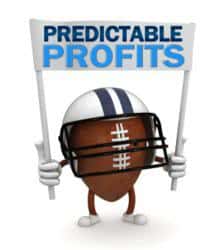
There aren’t many guarantees in life, and even fewer in marketing. But in the world of search engine marketing (SEM), using paid search (PPC) to rank on a search engine results page (SERP) for a given term comes pretty close. That’s why PPC is such good business for Google, which still generates 96% of its revenue through advertising -- because marketers know when they invest in PPC properly, they can get pretty close to guaranteed placement in the SERPs and help you generate leads.
The problem is, many marketers suffer from poor PPC campaign management, which ends up costing them way more money than they need to spend and delivering underwhelming lead generation results. So, how do you do PPC "properly" so you actually get leads at a reasonable cost? It comes down to intelligent campaign structure. And how do you master intelligent campaign structure? You use a template.
That's why we created a free PPC campaign management template that will help you -- or if you're an agency, the clients you're running campaigns for -- set up a full-funnel campaign structure that follows PPC best practices. Once you do that, you'll be better positioned to maximize the return on your PPC investment. We're going to show you how to use that PPC template in this blog post -- so download the template now so you can follow along with the explanation!
Bonus: If you're running PPC campaigns for someone who doesn’t understand the importance of good campaign structure, this template will also act as a deliverable that will enlighten your boss or clients.
Alright, got your template handy? Cool ... let's get started!
Tips for Using This Template
Before we get started, let's go over a few tips that'll make using this template even easier:- You will want to clear out the example data I have in the template such as keywords, campaign and AdGroup names, ads, and destination URLs. Unless, of course, you're running a fruit stand named after me.
- Be careful not to erase columns E, G, and I. They contain formulas that will help you in subsequent steps.
- Any red markers you see in the top corners of the cells contain helpful tips and FAQs -- if you ever forget what a cell is used for, those are good reminders.
Step 1: Understand PPC Campaign Structure
Before we actually do anything with this template, it's important we're all on the same page about PPC campaign structure. Far too many marketers ("too many" being defined as any number greater than 0) will just set up an account, create an ad, direct the ad to their home page, pick some keywords and hit go. This is not the way to do things.With AdWords, you have the opportunity to create multiple campaigns. Each campaign may contain several AdGroups, and each AdGroup may contain a few ads and multiple, similar keywords. It's wise to create multiple campaigns because you can set daily budget caps, day-parting, and select geo-targeted regions at the campaign level. If you're bidding on generic keywords and branded keywords, you'll want to put these in separate campaigns because the economics around these two types of keywords will likely be very different. As you can see, your template reflects these best practices, providing space for several different campaigns, AdGroups, and ad variations within those AdGroups.

Step 2: Identify Your Landing Pages
The "Destination URL" is the place on your website where you want the PPC traffic to end up. Because there is a marginal cost associated with each PPC visitor you attract, I recommend you choose a landing page URL as your destination URL. Do not drive them to your home page or a blog article in the hopes that they will stumble upon a lead generation form somewhere; that’s the job of organic search. Drive them to what we here at HubSpot define as a landing page, a web page with a form on it -- and don't forget to put in a tracking token so you know where these leads are coming from.
I know the big boys don’t always follow this rule, but the big boys also have millions of dollars in budget that needs to have evaporated at the end of the month. Make it easy on yourself and let your landing pages define your AdGroups and campaigns as you see in this template.
You will notice that, within an AdGroup, the Destination URL is the same regardless of the keyword or ad. If you really want to drive a keyword to a different landing page, then create another AdGroup -- or in the extreme, another campaign -- for that keyword.
You should also keep your sales funnel in mind when you identify these landing pages, and think about which part of the sales funnel each landing page and offer speaks to. For example, an educational PDF about an industry concept would be appropriate for a top-of-the-funnel offer, while a coupon or a demo would be at the bottom of the funnel. You will want to manage each part of the funnel separately, and therefore create separate campaigns. If you scroll down in your template, you'll see that there's dedicated space allotted for campaigns in all of these funnel stages.

Step 3: Build Your Keyword Strategy
Next, you will select the keywords that are relevant to the landing page and offer. Make sure to keep them as relevant as possible to increase the chance that each visitor you pay for completes the form on the landing page. Yes, it would be nice to rank for certain keywords, but if the landing page doesn’t answer the keyword queried, think twice. Or better yet, create another offer and landing page that speaks more directly to the keyword.
You can use free tools like the Google AdWords Keyword Tool or, if you're a HubSpot customer, our Keywords tool, to understand the actual search volumes and costs around each keyword you select. If you're running short on inspiration, these tools can help you think of other keywords to include in your campaign -- but always consider the costs of those suggested keywords and keep your economic interests in mind.
If this is your first time, it would be wise to read up on how to design a killer keyword strategy. And, in the case of AdWords, you could become a quick expert by becoming knowledgeable on the keyword quality score.
Step 4: Create Your Ads
This is the fun part! Both Google and Bing allow you to create more than one ad for each AdGroup (hence the "group" terminology) and the service will rotate them until it notices that one appears to drive a higher clickthrough rate (CTR). This is how A/B (and C and D) testing works. While it's optional, you should take advantage of the ability to create more than one ad.Writing an ad is a bit like writing a haiku. There are character limits for each part, and it can be a little aggravating figuring out how to best complete the ad. You are allotted 25 characters for the title, 35 characters for the display URL -- the URL that's displayed in the ad, not to be confused with the destination URL -- and 35 characters for each line of copy. But if you're using this template, don’t worry about keeping track! The cell to the right of each ad component will count characters and turn red when you have gone over the limit. Handy, right?

In my observation, the title has the greatest influence on an ad’s CTR. It's wise to include a keyword in the headline to draw a user’s attention to your ad. An even better practice would be to use dynamic keyword insertion. I find the copy to be less important, but you certainly can't just put gibberish in there. Search engines have editorial policies for what you can and cannot put in an ad, and they change it frequently, so it's your job to stay up to date on them. A good rule of thumb, however, is to simply try to provide a congruous experience for searchers -- from seeing your ad in the SERPs to completing the form on your landing page.

Finally, there's the tricky matter of the display URL. You're only allowed 35 characters here, but it's unlikely that your destination URL, the actual URL for your landing page, will be that short. So the search engines allow you to create a display URL, which may not even be an actual URL on your website. It is critical, however, that the domain in your display URL be the same as the domain in your destination URL.
Step 5: Share the Completed Template With a Decision Maker
Whether you're doing PPC for your business or a client, your completed template will ensure you're aligning the decision-maker’s expectations with the realities of a productive PPC campaign. If you're the decision maker, this template will help you really think about what you're doing with the money you're spending on PPC.The end result is that you'll have created the sort of congruous user experience that search engines like to see. That can benefit you in terms of your positioning in the SERPs and, ultimately, your costs. It will also grant you the agility you need to swiftly reallocate and modify budget as you respond to changes in the marketplace, and the drive to maximize the return on your PPC spend.
 The
summer of 2012 will be remembered as a roller coaster ride for
Facebook, weathering growing pains and declining stock values while
still keeping up a spirit of optimism for their potential growth. The
company’s disappointing IPO last May had some questioning whether the
site could adapt and remain an enduring part of popular culture. In
addition, when Facebook launched Timeline last year, some businesses
were dissatisfied with the opportunities available for promoting their
brands on the site.
The
summer of 2012 will be remembered as a roller coaster ride for
Facebook, weathering growing pains and declining stock values while
still keeping up a spirit of optimism for their potential growth. The
company’s disappointing IPO last May had some questioning whether the
site could adapt and remain an enduring part of popular culture. In
addition, when Facebook launched Timeline last year, some businesses
were dissatisfied with the opportunities available for promoting their
brands on the site. Many
people may be surprised to learn that only a portion of their Facebook
friends actually see their normal posts. That may happen for a variety
of reasons. For example, if people have thousands of friends, there
could be too much activity to appear on their news feed, so some content
posted by their friends gets omitted. In addition, if a friend is not
logged in to Facebook when you post something, there is a chance it
might not show up on their news feed. Promoted Posts prevent that
problem and give users assurance that their friends will at least have
the opportunity to view their posts. Promoted Posts are also more
prominently displayed on friends’ news feeds, thus increasing the
chances that your voice will be heard.
Many
people may be surprised to learn that only a portion of their Facebook
friends actually see their normal posts. That may happen for a variety
of reasons. For example, if people have thousands of friends, there
could be too much activity to appear on their news feed, so some content
posted by their friends gets omitted. In addition, if a friend is not
logged in to Facebook when you post something, there is a chance it
might not show up on their news feed. Promoted Posts prevent that
problem and give users assurance that their friends will at least have
the opportunity to view their posts. Promoted Posts are also more
prominently displayed on friends’ news feeds, thus increasing the
chances that your voice will be heard. Another
important feature of Promoted Posts is that users paying for the
service can track how effective their outreach efforts are. That is,
Facebook provides users with statistics on how many friends viewed these
posts so a user can actually objectively measure their promotional
success.
Another
important feature of Promoted Posts is that users paying for the
service can track how effective their outreach efforts are. That is,
Facebook provides users with statistics on how many friends viewed these
posts so a user can actually objectively measure their promotional
success. By
integrating this Open Graph tactic, Marmara, a French travel company,
generated 93K likes on its website, which in turn generated 13 million
impressions of their videos in the Facebook newsfeed! Not to mention the
16K clicks they got back to their website. All in just 2 weeks and for
free.
By
integrating this Open Graph tactic, Marmara, a French travel company,
generated 93K likes on its website, which in turn generated 13 million
impressions of their videos in the Facebook newsfeed! Not to mention the
16K clicks they got back to their website. All in just 2 weeks and for
free. With this feature, each blog article that you write automatically shares a video of your choice.
With this feature, each blog article that you write automatically shares a video of your choice. Here are the different sections of the update that appear on Facebook after someone likes your article.
Here are the different sections of the update that appear on Facebook after someone likes your article. Here are the Open Graph meta tags needed for this technique.
Here are the Open Graph meta tags needed for this technique. The Facebook post on the top has a photo, and the post on the bottom has a video embedded in it that is ready to play.
The Facebook post on the top has a photo, and the post on the bottom has a video embedded in it that is ready to play. Click
on the Play icon located on the picture and you will automatically
watch a video showcasing the product that you liked: a vacation resort.
Click
on the Play icon located on the picture and you will automatically
watch a video showcasing the product that you liked: a vacation resort. This is how the update appears in Facebook when someone likes my article published on my website.
This is how the update appears in Facebook when someone likes my article published on my website. Newsfeed before the click.
Newsfeed before the click. The ticker view.
The ticker view. The profile view.
The profile view. Specific WordPress plugins will allow you to personalize the Open Graph meta tags for each page or blog article.
Specific WordPress plugins will allow you to personalize the Open Graph meta tags for each page or blog article. Insert the link to your self-hosted .SWF video file here if you use the Like Button plugin for WordPress, for example.
Insert the link to your self-hosted .SWF video file here if you use the Like Button plugin for WordPress, for example. Once
you have your new URL format, insert it in your browser to test it out.
If the URL is right, the video should be displayed full screen (and fit
your entire browser window).
Once
you have your new URL format, insert it in your browser to test it out.
If the URL is right, the video should be displayed full screen (and fit
your entire browser window). Insert the link to your YouTube-hosted video here if you use the Social Graph Protocol Plugin, for example.
Insert the link to your YouTube-hosted video here if you use the Social Graph Protocol Plugin, for example..png)
.png)
.png)


 Use a compelling description to encourage people to join your group.
Use a compelling description to encourage people to join your group. Example of a firm and clear LinkedIn group rules policy.
Example of a firm and clear LinkedIn group rules policy. Highlight your group policy in the Manager's Choice area.
Highlight your group policy in the Manager's Choice area. Craft clear messaging templates to auto-send on your behalf.
Craft clear messaging templates to auto-send on your behalf. Send group announcements with compelling subject lines to stand out.
Send group announcements with compelling subject lines to stand out. Lead your group by being engaged and vocal!
Lead your group by being engaged and vocal!
 The Social Media Marketing podcast is a show from Social Media Examiner.
The Social Media Marketing podcast is a show from Social Media Examiner.


 Kodak is a great example of a brand that Mark has worked with.
Kodak is a great example of a brand that Mark has worked with. Mark has his pizza delivered to the Apple store.
Mark has his pizza delivered to the Apple store. Beyond the To Do List is a great place to pick up some tips.
Beyond the To Do List is a great place to pick up some tips.

 Always label your cover/first image.
Always label your cover/first image. The image name will appear in the description.
The image name will appear in the description. If possible, write a message on the image.
If possible, write a message on the image. Adding the website address to your pins can increase traffic.
Adding the website address to your pins can increase traffic. When you look at the above image, you instantly know the source and the artist who created it.
When you look at the above image, you instantly know the source and the artist who created it. Asking for pins and repins might get you more of them.
Asking for pins and repins might get you more of them. Keep the length of your descriptions between 200 and 300 characters.
Keep the length of your descriptions between 200 and 300 characters.